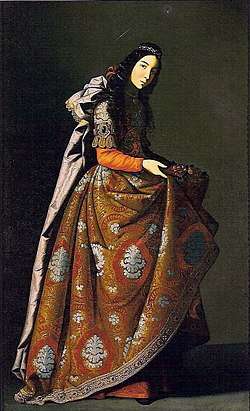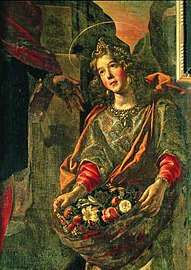Casilda of Toledo
Saint Casilda of Toledo (Spanish: Santa Casilda de Toledo) (died c. 1050) is venerated as a saint of the Roman Catholic Church and Orthodox Church. Her feast day is April 9.
Saint Casilda de Toledo | |
|---|---|
 Saint Casilda, by Francisco de Zurbarán | |
| Died | ~1050[1] |
| Venerated in | Roman Catholic Church, Eastern Orthodox Church |
| Feast | April 9 |
| Attributes | Roses in her basket or dress |
Life
According to her legend, St. Casilda, a daughter of a Muslim king of Toledo (likely Yahya ibn Ismail Al-Mamun), showed great compassion for Christian prisoners by frequently sneaking bread into the prison, hidden in her clothes, to feed them.[2] Once, she was stopped by Muslim soldiers and asked to reveal what she was carrying in her skirt. When she began to show them, the bread turned into a bouquet of roses.[3]
She was raised a Muslim, but when she became ill as a young woman, she refused help from the local Arab doctors and traveled to northern Iberia to partake of the healing waters of the shrine of San Vicente, near Buezo, close to Briviesca.[2][3] When she was cured, she was baptized at Burgos (where she was later venerated) and lived a life of solitude and penance not far from the miraculous spring. It is said that she lived to be 100 years old[4].
Images
 Saint Casilda, by Francisco de Zurbarán
Saint Casilda, by Francisco de Zurbarán Saint Casilda, by Juan Rizi
Saint Casilda, by Juan Rizi St. Casilda Apprehended with her Basket, Burgos Cathedral
St. Casilda Apprehended with her Basket, Burgos Cathedral
Painted between 1638 and 1642, Zurbarán's Santa Casilda used as its model a lady of the Spanish court. She wears the fashions for courtiers of the time.[3]
Bibliography
- Concha Espina, Casilda de Toledo (Madrid: Biblioteca nueva, 1940)
See also
- Miracle of the roses
- Saint Casilda of Toledo, patron saint archive
References
- "St. Casilda of Toledo, Spain", Antiochian Orthodox Christian Archdiocese of North America
- "St. Casilda", Franciscan Media
- Zurbaran
- Butler, Alban; Burns, Paul (1999-01-01). Butler's Lives of the Saints: April. A&C Black. p. 66. ISBN 978-0-86012-253-1.